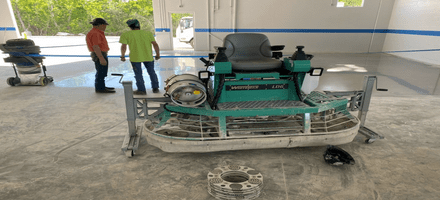Power trowels are primarily used in surface preparation to apply smooth finishes to concrete slabs. This machine has assisted professionals with concrete surface work for over several decades and continues to evolve with the times.
Not only can you use a power trowel for finishing concrete floors, but with the right adjustments to your system, you can also use it for polishing – making this a multifaceted machine well worth the investment.
At Runyon Surface Prep, we offer a catalog of all things surface preparation – from trowels and floor grinders to tooling and industrial vacuums. As a full-service rental and sales team who prides themselves on the distribution of Multiquip Trowel Machines and accessories, we’ve decided to provide some education on power trowels for anyone interested in getting to know them.
Trowels: What They Are and How They Work
The main purpose of a trowel in construction and concrete surface installation is to create a smooth, unmarked finish as new concrete settles. The process also aids the concrete in eliminating water from the slab. And most trowels, especially walk-behind models, are relatively easy to master in a short amount of time.
The Parts of a Power Trowel
The parts of a trowel can vary depending on whether you’re working with a walk-behind or ride-on machine, but some main pieces you’ll find in the makeup of a traditional walk-behind trowel are:
- Engine
- Spider assembly
- Blades
- Safety ring
- Handle
- Gearbox
In addition to much of the same parts in the walk-behind, the ride-on trowel will also typically include the following:
- LED lighting for night and indoor work
- Twin Pitch Control which allows for simultaneous control of rotors without strenuous effort
- Gas tank that will vary in capacity depending on model
- All necessary filters and belts
When to Use a Walk-Behind Trowel
Walk-behind trowels are affordable, relatively easy to operate when following the manufacturer’s directions, and often used in less-demanding projects than the ride-on counterpart. You may use a walk-behind trowel if you’re working the surface of a driveway, a single room in a commercial or residential building, or the floor of a pool.
When to Use a Ride-On Trowel
Floor installation and concrete finishing for large surface areas will benefit most from a ride-on trowel. Not only will the finish look exquisite, but your workers will thank you for the extra help. If you want to save on labor while covering the most possible space in the shortest possible time frame, go with a ride-on model.
These machines come in 6, 8, and 10-foot models and are usually gas powered. Though, Runyon offers propane conversion for the Multiquip LD6.
Polishing Concrete Floors With a Power Trowel
Another beautiful element of a power trowel is its variability. Workers who may otherwise bring in a floor grinder to polish off the concrete surface can go ahead and leave that machine in the shop, since the trowel may also be used in the polishing step. Of course, that would require removing the blades.
Still, the convenience of this alternate trowel use is one that more and more professionals are taking advantage of every year. Perhaps that’s because trowels have the potential to leave a polish just as good as your everyday machine and have been shown to reduce labor by nearly 75% when compared to the traditional planetary method.
Change Grits Quickly and Easily
The RSP Magnetic Preload System allows for a fast switch of diamond tooling when polishing with a ride-on trowel. All you need to do is pull off the magnetic ring from the driver and replace it with the new ring holding the next grit or step in your system.
